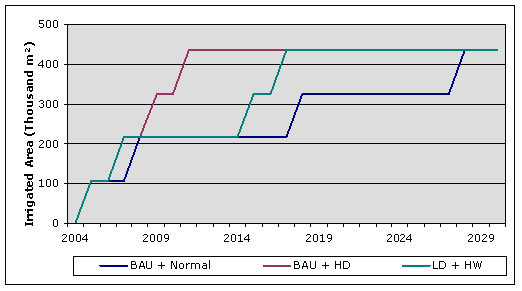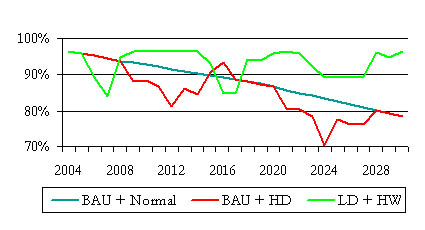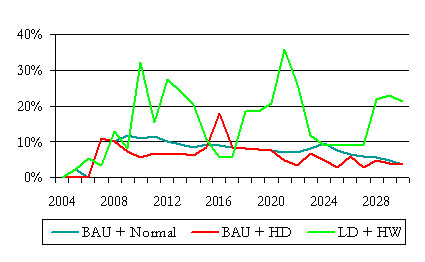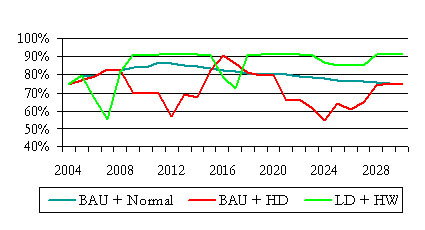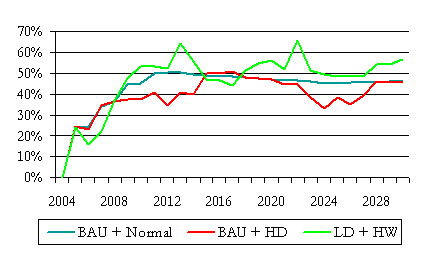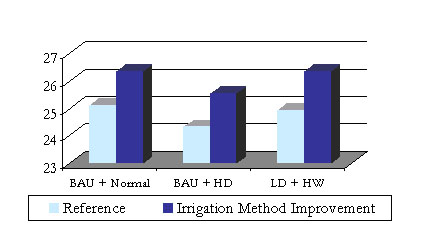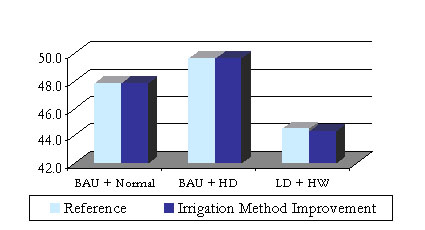
ISSUE 6 |
||||||||||||||||||||||||||||||||||||||||||||||||||||
|
|
|||||||||||||||||||||||||||||||||||||||||||||||||||
Option results |
||||||||||||||||||||||||||||||||||||||||||||||||||||
|
Figure 1 presents the scheduling for the application of drip irrigation in the municipal department of Agairia under the three scenarios. Figure 1. Application of drip irrigation in Agairia under the three scenarios |
||||||||||||||||||||||||||||||||||||||||||||||||||||
|
|
||||||||||||||||||||||||||||||||||||||||||||||||||||
Effectiveness |
||||||||||||||||||||||||||||||||||||||||||||||||||||
|
Effectiveness to domestic demand coverage presents minor increases under all three scenarios and exhibits a decreasing trend as the demand escalates (Figure 2). The improvement of domestic deficit with respect to each reference scenario is minor, with maximum values ranging from 12% (BAU+Normal) to 35% for the wet periods of the LD+HW scenario (Figure 3). This is due to the reduction of irrigation demand and therefore groundwater abstractions during the low peak months, which results in higher groundwater availability for the prioritised domestic use during the peak summer period. Figure 2. Percent demand coverage effectiveness of Improvement of Irrigation Methods to Domestic use Figure 3. Percent Improvement of deficit in Domestic use with respect to the reference scenarios Figure 4. Percent demand coverage effectiveness of Improvement of Irrigation Methods to Irrigation use Improvement in irrigation demand coverage is of course very important, reaching a maximum of 90% in terms of effectiveness and of approximately 65% in terms of relative deficit improvement (Figure 4 and Figure 5). However, it should be emphasised that even after irrigation method improvements, irrigation demand is not fully met. Additionally, irrigation deficit improvement is much lower in cases of drought, when available supply is low and a higher priority is given to domestic uses.
Figure 5. Percent Improvement of deficit in Irrigation use |
||||||||||||||||||||||||||||||||||||||||||||||||||||
Direct and Environmental Costs |
||||||||||||||||||||||||||||||||||||||||||||||||||||
|
Direct cost increases are relatively low, ranging from 5% under normal (average) conditions to 5.6 % under a high wet frequency (Figure 6). The small increase is due to the increase of two cost components:
Figure 6. Total direct cost difference of the Improvement of Irrigation
Methods option The total environmental cost does not differ much after the implementation of the option, presenting only a marginal decrease. As previously stated, since both domestic and irrigation demands are not fully met, all available resources are exploited; thus environmental costs associated with groundwater abstraction remain constant (Figure 7).
Figure 7. Total environmental cost difference of the Improvement of
Irrigation Methods |
||||||||||||||||||||||||||||||||||||||||||||||||||||
